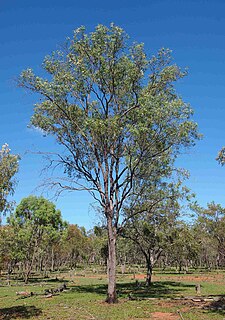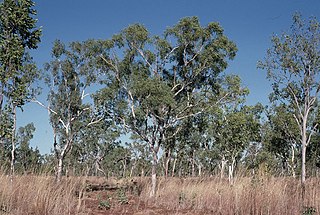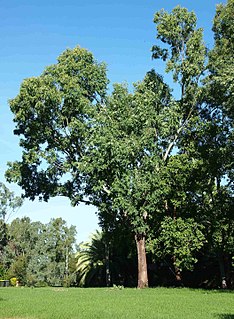
Eucalyptus microcorys, commonly known as tallowwood, is a species of medium to tall tree that is endemic to eastern Australia. It has rough, fibrous or string bark on the trunk and branches, lance-shaped to egg-shaped adult leaves, flower buds in groups of seven or nine, white to lemon-yellow flowers and conical fruit. It grows in forests near the coast of Queensland and New South Wales.

Eucalyptus crebra, commonly known as the narrow-leaved ironbark, narrow-leaved red ironbark or simply ironbark, and as muggago in the indigenous Dharawal language, is a species of small to medium-sized tree endemic to eastern Australia. It has hard, rough "ironbark" from its trunk to small branches, linear to lance-shaped adult leaves, flower buds in groups of seven, nine or eleven, white flowers and cup-shaped, barrel-shaped or hemispherical fruit. A variable species, it grows in woodland and forest from the Cape York Peninsula to near Sydney. It is an important source of nectar in the honey industry and its hard, strong timber is used in construction.

Eucalyptus fibrosa, commonly known as the red ironbark, broad-leaved red ironbark or broad-leaved red ironbark, is a species of medium-sized to tall tree endemic to eastern Australia. It has grey to black ironbark, lance-shaped to egg-shaped adult leaves, flower buds in groups of between seven and eleven, white flowers and conical fruit.

Eucalyptus moluccana, commonly known as the grey box, gum-topped box or terriyergro, is a medium-sized to tall tree with rough bark on part or all of the trunk, smooth bark above, lance-shaped adult leaves, flower buds usually in groups of seven, white flowers and cup-shaped to barrel-shaped fruit. It is found in near-coastal areas of Queensland and New South Wales.

Corymbia polycarpa, also known as the long-fruited bloodwood or small-flowered bloodwood, is a species of tree that is endemic to northern Australia. Indigenous Australians of different language groups have different names for the tree. The Nungali peoples know the tree as narrga or gunjid, the Mulluk-Mulluk know it as dawart, the Yangman know it as bodog, the Gurindji peoples as jadburru and the Wagiman as jagatjjin. It is a medium-sized tree with rough, tessellated bark on the trunk and branches, lance-shaped to curved adult leaves, flower buds in groups of seven or nine, white or cream-coloured flowers and barrel-shaped fruit.

Eucalyptus woollsiana is a species of tree that is endemic to eastern Australia. It has rough, fibrous bark on the trunk, smooth bark above, lance-shaped adult leaves, flower buds in groups of five or seven, white flowers and cup-shaped fruit.

Corymbia tessellaris, commonly known as carbeen or Moreton Bay ash, is a species of tree that is endemic to north-eastern Australia. It has rough, tessellated bark on the lower trunk abruptly changing to smooth, whitish bark above, narrow lance-shaped adult leaves, flower buds in groups of three or seven, white flowers and cylindrical or urn-shaped fruit

Corymbia terminalis, also known as tjuta, joolta, bloodwood, desert bloodwood, plains bloodwood, northern bloodwood, western bloodwood or the inland bloodwood, is a species of small to medium-sized tree, rarely a mallee that is endemic to Australia. It has rough, tessellated bark on some or all of the trunk, sometimes also on the larger branches, smooth white to cream-coloured bark above, lance-shaped adult leaves, flower buds in groups of seven, white flowers and urn-shaped fruit.

Eucalyptus conica, commonly known as fuzzy box, is a species of tree endemic to eastern Australia. It has rough, flaky bark on the trunk and larger branches, smooth above, lance-shaped adult leaves, oval to diamond-shaped flower buds mostly arranged on a branching inflorescence on the ends of the branchlets, white flowers and conical fruit.

Eucalyptus microtheca, commonly known as the coolibah, is a species of tree that is endemic to northern Australia. It has rough, flaky or fibrous bark on the trunk and branches, lance-shaped adult leaves, flower buds in groups of seven, white flowers and spherical to conical fruit. It is widely distributed from the Kimberley region of Western Australia to Cape York in Queensland.

Corymbia trachyphloia, commonly known as the brown bloodwood, is a species of small to medium-sized tree that is endemic to eastern Australia. It has rough, tessellated bark on the trunk, often also on the larger branches, lance-shaped adult leaves, flower buds in groups of seven, white flowers and urn-shaped fruit.

Eucalyptus exserta, commonly known as Queensland peppermint, peppermint, bendo, yellow messmate or messmate, is a species of tree or a mallee and is endemic to eastern Australia. It has hard, fibrous bark, lance-shaped adult leaves, flower buds in groups of seven, white flowers and hemispherical or cup-shaped fruit.

Eucalyptus intertexta, commonly known as inland red box, western red box, gum coolibah or the bastard coolibah, is a species of tree that is endemic to central Australia. It has rough, fibrous or flaky bark on the base of the trunk, smooth white to brownish bark above, lance-shaped adult leaves, flower buds in groups of seven on the ends of branchlets, white flowers and cup-shaped to hemispherical fruit.

Eucalyptus rudderi, or Rudder's box, is a species of tree that is endemic to northern New South Wales. It has rough fibrous or flaky bark on the trunk and branches, lance-shaped adult leaves, flower buds in groups of seven, white flowers and barrel-shaped or hemispherical fruit.

Eucalyptus tectifica, commonly known as Darwin box, or grey box, is a species of tree that is endemic to northern Australia. It has rough, fibrous or flaky bark on the trunk and branches, lance-shaped or curved adult leaves, flower buds usually in groups of seven, creamy white flowers and conical, cup-shaped or barrel-shaped fruit.

Eucalyptus tetrodonta, commonly known as Darwin stringybark or messmate, is a species of medium-sized to tall tree that is endemic to northern Australia. It has rough, stringy or fibrous bark on the trunk and branches, lance-shaped leaves arranged in opposite pairs, flowers buds in groups of three, whitish to cream-coloured flowers and cylindrical fruit.

Eucalyptus thozetiana is a species of tree that is native to inland north-eastern Australia. It has smooth bark, or sometimes with rough bark near the base, linear to lance-shaped adult leaves, flower buds in groups of between seven and eleven, white flowers and urn-shaped, barrel-shaped or cylindrical fruit.

Eucalyptus howittiana, commonly known as Howitt's box, is a species of tree that is endemic to a small area of Queensland. It has rough, fibrous and flaky bark on the trunk and branches, lance-shaped or egg-shaped adult leaves, flower buds in groups of between seven and eleven, creamy white flowers and shortened spherical to barrel-shaped fruit.

Eucalyptus microneura, commonly known as Gilbert River box, is a species of small to medium-sized tree that is endemic to Queensland. It has rough, fibrous or flaky bark on the trunk and branches, lance-shaped adult leaves, flowers in groups of seven on a branching peduncle, white flowers and conical fruit.

Eucalyptus raveretiana, commonly known as the black ironbox, is a species of small to medium-sized tree that is endemic to Queensland. It has rough, fibrous or flaky bark on the trunk and larger branches, smooth pale grey bark above, lance-shaped leaves, flower buds in groups of seven on a branched peduncle, white flowers and small, hemispherical fruit.




















